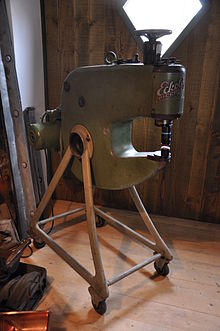Upsetting
Under compression refers to a relative length variation of a flow pressure forces the claimed body . Corresponding relationships with opposite signs apply between compression and elongation due to the opposites .
Materials can be changed in their shape, length or thickness by upsetting. They keep their original volume , provided the material is not porous .
This can also be done in the cold way. A special tool was developed for this around 1936, the Eckold Kraftformer . Here, two split jaws come from below and above, between which the sheet is clamped. In the next work step, the split jaws push the sheet against each other in a transverse movement, thereby compressing it. These power formers are used in the aerospace and automotive industries to manufacture shaped sheet metal parts, frames and stringers from sheet iron and aluminum alloys.
The compression ratio is the ratio of the free, i.e. H. not guided, length of a blank to its diameter . If the permissible upsetting ratio is exceeded, there is a risk of buckling during the upsetting process .
See also
literature
- Rolf Hinkfoth: Solid forming: selected technological basics of the forming processes in metallurgy. Wissenschaftsverlag, Mainz; Aachen 2003, ISBN 3-86130-184-9
